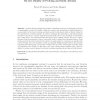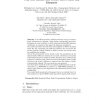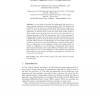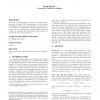ET
2010
14 years 4 months ago
2010
In this work we investigate the problem of simultaneous privacy and integrity protection in cryptographic circuits. We consider a white-box scenario with a powerful, yet limited at...
CTRSA
2008
Springer
14 years 7 months ago
2008
Springer
We present a study of several fault attacks against the block cipher IDEA. Such a study is particularly interesting because of the target cipher's specific property to employ ...
FDTC
2006
Springer
14 years 9 months ago
2006
Springer
We present a new type of fault attacks on elliptic curve scalar multiplications: Sign Change Attacks. These attacks exploit different number representations as they are often emplo...
CHES
2006
Springer
14 years 9 months ago
2006
Springer
It is well known that a malicious adversary can try to retrieve secret information by inducing a fault during cryptographic operations. Following the work of Seifert on fault induc...
CHES
2006
Springer
14 years 9 months ago
2006
Springer
Abstract. In this paper we describe two differential fault attack techniques against Advanced Encryption Standard (AES). We propose two models for fault occurrence; we could find a...
CHES
2000
Springer
14 years 10 months ago
2000
Springer
This paper will attempt to explain some of the side-channel attack techniques in a fashion that is easily comprehensible by the layman. What follows is a presentation of three di�...
ASIACRYPT
2009
Springer
14 years 10 months ago
2009
Springer
A fault attack consists in inducing hardware malfunctions in order to recover secrets from electronic devices. One of the most famous fault attack is Bellcore’s attack against RS...
FC
2003
Springer
14 years 11 months ago
2003
Springer
Abstract. In this paper we describe several fault attacks on the Advanced Encryption Standard (AES). First, using optical/eddy current fault induction attacks as recently publicly ...
CCS
2004
ACM
14 years 11 months ago
2004
ACM
We study a countermeasure proposed to protect Chinese remainder theorem (CRT) computations for RSA against fault attacks. The scheme was claimed to be provably secure. However, we...
IOLTS
2005
IEEE
14 years 11 months ago
2005
IEEE
Selecting a strong cryptographic algorithm makes no sense if the information leaks out of the device through sidechannels. Sensitive information, such as secret keys, can be obtai...




